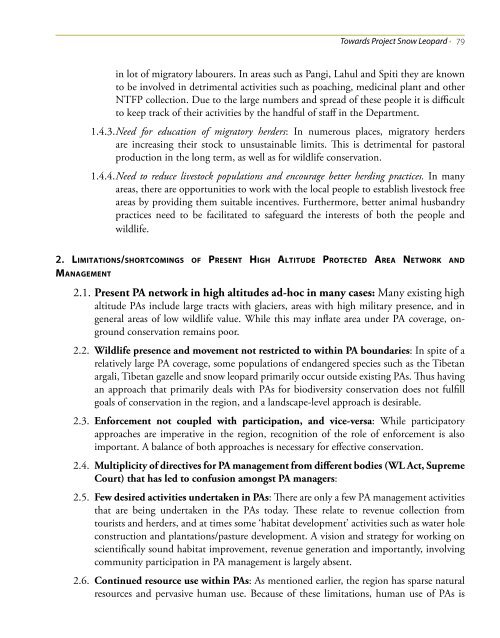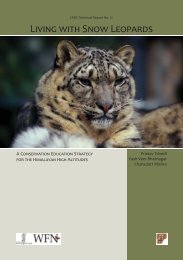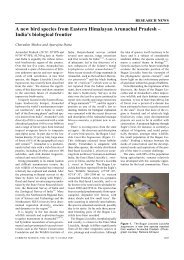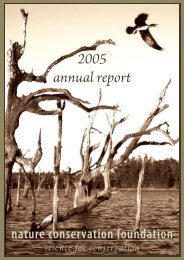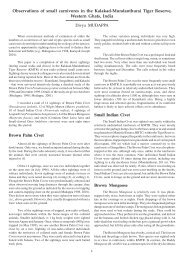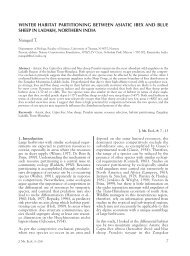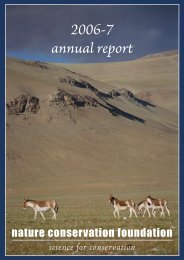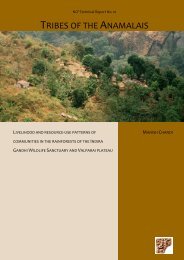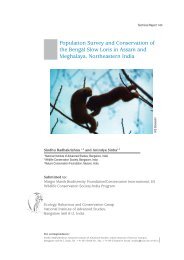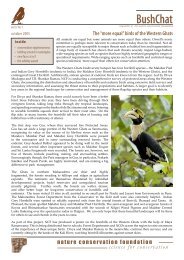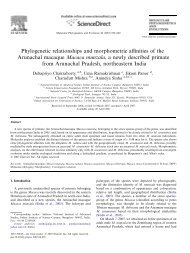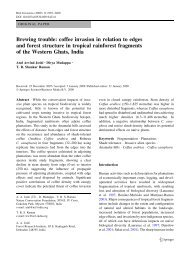towards project snow leopard - Nature Conservation Foundation
towards project snow leopard - Nature Conservation Foundation
towards project snow leopard - Nature Conservation Foundation
Create successful ePaper yourself
Turn your PDF publications into a flip-book with our unique Google optimized e-Paper software.
Towards Project Snow Leopard • 79<br />
in lot of migratory labourers. In areas such as Pangi, Lahul and Spiti they are known<br />
to be involved in detrimental activities such as poaching, medicinal plant and other<br />
NTFP collection. Due to the large numbers and spread of these people it is difficult<br />
to keep track of their activities by the handful of staff in the Department.<br />
1.4.3. Need for education of migratory herders: In numerous places, migratory herders<br />
are increasing their stock to unsustainable limits. This is detrimental for pastoral<br />
production in the long term, as well as for wildlife conservation.<br />
1.4.4. Need to reduce livestock populations and encourage better herding practices. In many<br />
areas, there are opportunities to work with the local people to establish livestock free<br />
areas by providing them suitable incentives. Furthermore, better animal husbandry<br />
practices need to be facilitated to safeguard the interests of both the people and<br />
wildlife.<br />
2. Limitations/shortcomings of Present High Altitude Protected Area Network and<br />
Management<br />
2.1. Present PA network in high altitudes ad-hoc in many cases: Many existing high<br />
altitude PAs include large tracts with glaciers, areas with high military presence, and in<br />
general areas of low wildlife value. While this may inflate area under PA coverage, onground<br />
conservation remains poor.<br />
2.2. Wildlife presence and movement not restricted to within PA boundaries: In spite of a<br />
relatively large PA coverage, some populations of endangered species such as the Tibetan<br />
argali, Tibetan gazelle and <strong>snow</strong> <strong>leopard</strong> primarily occur outside existing PAs. Thus having<br />
an approach that primarily deals with PAs for biodiversity conservation does not fulfill<br />
goals of conservation in the region, and a landscape-level approach is desirable.<br />
2.3. Enforcement not coupled with participation, and vice-versa: While participatory<br />
approaches are imperative in the region, recognition of the role of enforcement is also<br />
important. A balance of both approaches is necessary for effective conservation.<br />
2.4. Multiplicity of directives for PA management from different bodies (WL Act, Supreme<br />
Court) that has led to confusion amongst PA managers:<br />
2.5. Few desired activities undertaken in PAs: There are only a few PA management activities<br />
that are being undertaken in the PAs today. These relate to revenue collection from<br />
tourists and herders, and at times some ‘habitat development’ activities such as water hole<br />
construction and plantations/pasture development. A vision and strategy for working on<br />
scientifically sound habitat improvement, revenue generation and importantly, involving<br />
community participation in PA management is largely absent.<br />
2.6. Continued resource use within PAs: As mentioned earlier, the region has sparse natural<br />
resources and pervasive human use. Because of these limitations, human use of PAs is


